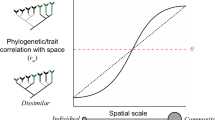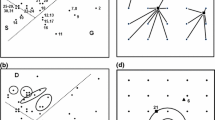Summary
Concepts and methods for use in the study of plant community variation across a single landscape, or for the comparative analysis of two or more landscapes, are presented. The method is called affinity analysis because it produces a sorting and scaling of all the communities in a data set according to degree of differentiation in composition away from an objectively identified subset of modal communities. Modal communities possess maximum affinity with the whole landscape because they contain a large number of the species common throughout the landscape. The modal communities provide a kind of central tendency for the landscape and an anchor for depicting the dispersion of all other communities in it.
To accomplish affinity analysis, the Jaccard similarity coefficient and the WilcoxonT statistic are used in a two-step transformation of the primary species-by-site data matrix. From these calculations we obtain both a visual image, theS-T graph, and summary statistics for the landscape-wide diversity described by the data. One summary statistic is a high-order diversity measure for the total patchwork of communities. We refer to this measure as mosaic diversity. The analytical results are referred to collectively as the ‘metastructure’ because they provide a general, abstract, characterization of any set of community data. This abstract rendering of the data allows comparison of pattern and variation between taxonomically, geographically, and temporally different landscapes. Either presence/absence or abundance data may be used.
Examples using artificial and field data are presented. All but one of the field data sets showed a significantly higher mosaic diversity than would be expected from a randomly constructed landscape. We also show how the new methods may be used with ordination to explore intralandscape patterns in more detail than was previously possible.
In addition to statistical matters, ecological and evoutionary interpretations of affinity analysis are discussed. Topics included in this discussion involve reasoning about the influences on diversity arising from micro- and macroevolution, species packing and association, environmental gradients, differential fitness expression among species-populations, continuity in community variation, and the uses of both presence/absence and abundance data in community studies. Among the examples provided, mosaic diversity is independent of β diversity (Whittaker, 1972).
Similar content being viewed by others
References
Avena, G., Blasi, C., Feoli, E. and Scoppola, A. (1981) Measurement of the predictive value of species lists for species cover in phytosociological samples.Vegetatio 45, 77–84.
Coleman, B. B. and Istock, C. A. (1980) Ecological pattern in the moss species ensembles of a hemlock-hardwood forest mosaic.Evolutionary Theory 5, 1–27.
Eberhardt, L. L. (1969) Some aspects of species diversity models.Ecology 50, 503–5.
Efron, B. (1981) Nonparametric estimates of standard error: the jackknife, the bootstrap and other methods.Biometrika 68, 589–99.
Etges, W. J. (1984) Genetic structure and change in natural populations ofDrosophila robusta: systematic inversion and inversion association frequency shifts in the Great Smoky Mountains.Evolution 38, 675–88.
Faith, D. P. (1983) Assymetric binary similarity measures.Oecologia 57, 287–90.
Gauch, H. G. (1982)Multivariate Analysis in Ecology. Cambridge University Press, New York.
Goodall, D. W. (1973) Sample similarity and species correlation. InOrdination and Classification of Communities (H. Whittaker, ed.) pp. 105–56. W. Junk, The Hague.
Griffin, E. A., Hopkins, A. J. M. and Hnatiuk, R. J. (1983) Regional variation in mediterranean-type scrublands near Eneabba, south-western Australia.Vegetatio 52, 103–27.
Jaccard, P. (1901) Distribution de la flore alpine dans le Bassin des Dranes et dans quelques régions voisines.Bulletin de la Société vaudoise des Sciences Naturelles 37, 241–72.
Janson, S. and Vegelius, J. (1981) Measures of ecological association.Oecologia 49, 371–8.
MacAarthur, R. H. (1972)Geographical Ecology. Harper & Row, New York.
Mueller-Dombois, D. and Ellenberg, H. (1974)Aims and Methods of Vegetation Ecology. John Wiley, New York.
Nichols, G. E. (1935) The hemlock-white pine-northern hardwoods region of eastern North America.Ecology 16, 403–22.
Oosting, H. J. (1942) An ecological analysis of plant communities of Piedmont, North Carolina.Amer. Midl. Nat. 28, 1–26.
Peet, R. K. (1974) The measurement of species diversity.Annual Review of Ecology and Systematics 5, 285–307.
Peet, R. K. and Loucks, O. L. (1977) A gradient analysis of southern Wisconsin forests.Ecology 58, 485–99.
Pielou, E. C. (1975)Ecological Diversity. Wiley-Interscience, New York.
Siegel, S. (1956)Nonparametric Statistics for the Behavioral Sciences. McGraw-Hill, New York.
Snedecor, G. W. and Cochran, W. G. (1967)Statistical Methods. Iowa State University Press, Ames, Iowa.
Whittaker, R. H. (1972) Evolution and measurement of species diversity.Taxon 21, 213–51.
Wolda, H. (1981) Similarity indices, sample size and diversity.Oecologia 50, 296–302.
Author information
Authors and Affiliations
Rights and permissions
About this article
Cite this article
Istock, C.A., Scheiner, S.M. Affinities and high-order diversity within landscape mosaics. Evol Ecol 1, 11–29 (1987). https://doi.org/10.1007/BF02067265
Issue Date:
DOI: https://doi.org/10.1007/BF02067265




